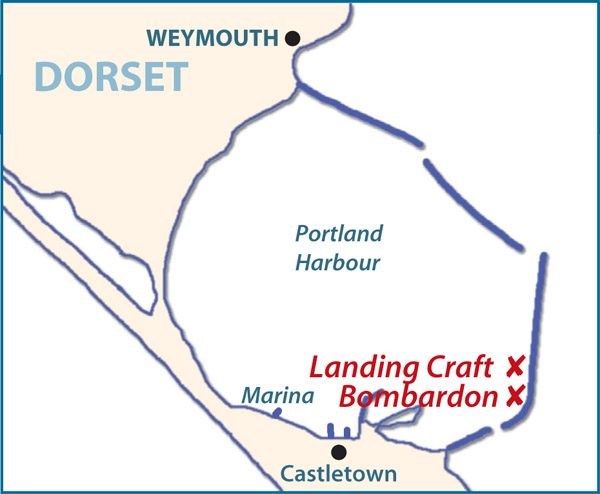JOHN LIDDIARD turns his attention to a really old wreck, a paddle-steamer that lies in two halves off south-west Wales. The wheel is a tricky optional extra! Illustration by MAX ELLIS
WE RETURN to the north coast of Pembrokeshire and a wreck of three halves! The paddle-steamer Nimrod was swept onto the rocks on 27 February, 1860, breaking its back pretty much where the paddle-shaft ran across the ship.
The forward and aft parts then fell into deeper water, leaving the smashed remains of a paddle-wheel in the shallows.
Our tour of two halves will be covering the bow and stern as separate dives, and leave the remnants of the paddle-wheel as just that. As both halves require slack water, even if diving them both on the same day the few metres of difference in depth is unlikely to be important. Nevertheless, our first dive is to the bow.
BOW SECTION
Our tour begins on the shallower side of the wreck, on the remains of the port boiler (1) at a depth of 27m. Built in 1843, this is from before the invention of the more usual cylindrical “Scotch” boiler, and is a flat, arched shape with two furnaces and fire-tubes, so an obvious predecessor of the Scotch boiler.
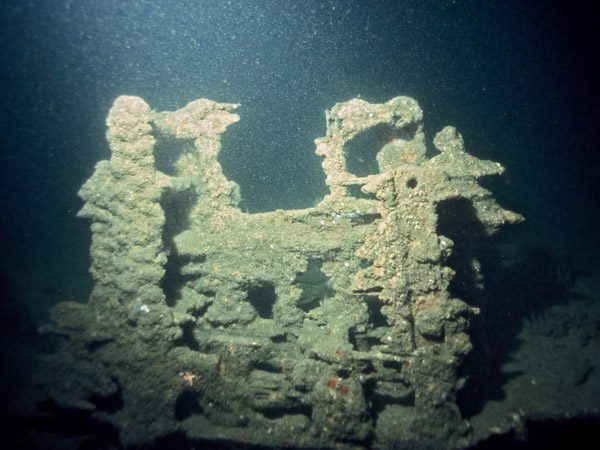
Forward from the boiler are the remains of a small two-cylinder engine (2), perhaps a pump. The hull is flat to the seabed, with an obvious grid of ribs that can be used to assist navigation.
As our dive continues forward along the port side of the wreck, some of the ribs end in braced sections that would have supported the side of the hull, then further forward some plates from the sides of the hull lie outside the main body of the wreck.
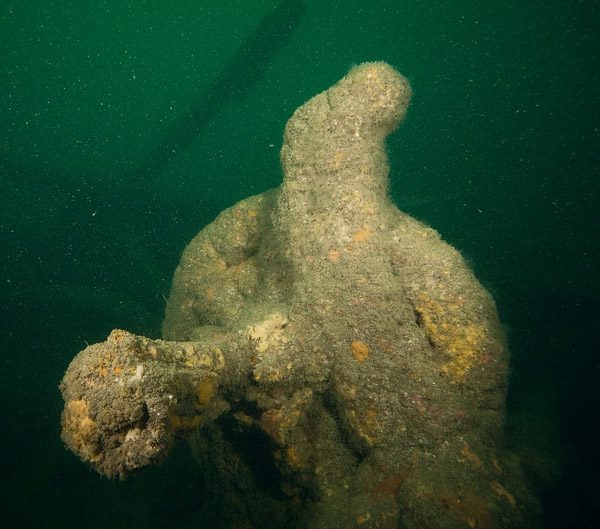
A long spindle from a combined anchor and cargo-winch (3) crosses most of the width of the wreck.
The bow itself, with a noticeable stem-post (4), is flattened to starboard. The pattern of ribs changes with a series of V-sections laid over them.
Off the bow, the last item of wreckage is a tubular section of what I thought at the time was the mast, but now in retrospect think was part of the bowsprit (5). It certainly isn’t an anchor hawse-pipe, because one anchor hawse-pipe remains within the bow (6), and has a much more solid construction.
Now heading aft along the starboard side, the depth has increased to 31m.
The second spindle from the winch (7) lies skewed across the side of the wreck. Almost directly out from this and a metre or so deeper is a flat scrap of boxed section (8), perhaps from the base of the winch.
Just outside the hull, among the stones and gravel of the seabed, are some broken shards of pottery (9), with more among the ribs of the hull (10).
Please leave them on the wreck for others to appreciate. They hold no value and are just broken pieces. Searching for them and examining them is all part of the fun of this dive.
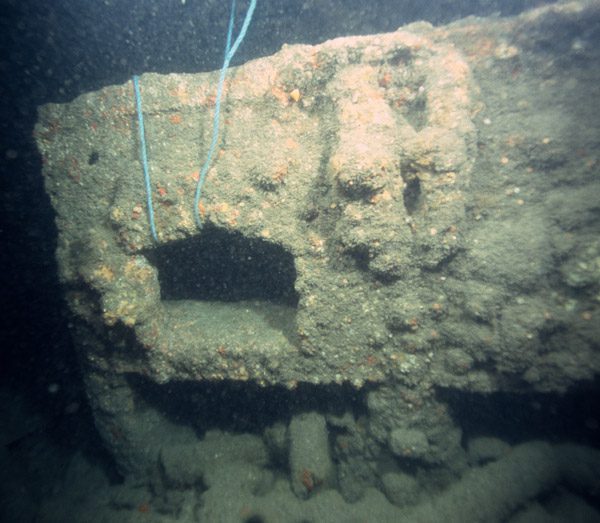
About halfway back to the boilers, a small anchor (11) is neatly aligned along the hull – perhaps a spare anchor carried on deck. It is unlikely that an anchor of this size would subsequently have become fouled and lost.
Our route then passes a section of mast, before coming to the starboard boiler (12). While originally the expected duplicate of the port boiler, this is considerably more broken, with the end-plate (13) separated from the actual tubes.
The stern part of the wreck is a good 100m away. I have heard of divers crossing the gap, but I have also heard of divers trying and missing. It is not a crossing I have ever attempted.
With big currents likely to be picking up as slack water ends, it makes more sense to either ascend the shotline with a few minutes’ safety stop, or to swim a little way south into the bay to release a delayed SMB.
STERN SECTION
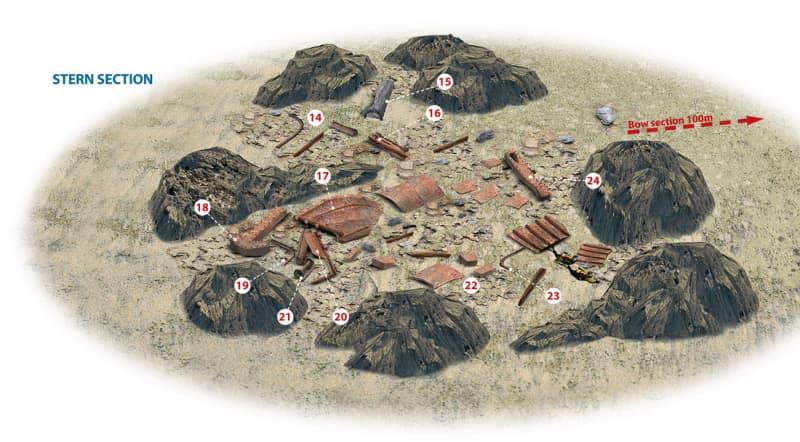
The stern part of the Nimrod is considerably more scattered, and lies among rocks that stand higher from the seabed than the wreck does. It’s the sort of wreckage that will barely show on the best of echo-sounders, so a dive is more likely to begin with a random dropping of the shot on the GPS numbers and a general depth of 25-28m.
My dive began with the shotline landing among some curved sections (14) at about 26m. Following the general trail of debris among the rocks, the shallowest item I could find in this part of the wreck was the crushed remains of a water tank (15) at a depth of 25m.
Immediately downhill, a heavy girder-section with a piston alongside (16) could have been part of the steam engine.
From here, the general trail of wreckage leads deeper and round a protruding rock past some curved hull-plates and then a rounded section that would have been the actual stern (17).
Continuing in the same direction, just off the stern is a very heavily built rectangular box-section (18), almost in the shape of an enormous boxed hammer. As to its original purpose, I have no idea and am open to suggestions.
It could even be part of a dismantled engine, as the crew would have been frantically trying to repair it.
Slightly deeper and between this section and the rounded stern is a small curved boat derrick (19), the rudder (20) and the spindle of a small winch (21); much smaller than that encountered near the bow.
The rudder has simple tiller steering attached to the top of the rudder-post.
Our path across the trail of wreckage now turns along the slope to the west, with general wreckage and several open metal boxes (22), and then the other boat derrick from a pair (23), demonstrating how scattered this part of the wreck is.
The rocks below to the north and west again mark the limit of wreckage, and our route now turns up the slope past some scattered plates and another big rectangular box-section (24).
Again, with current likely to be building soon, a return to the shotline for a short ascent or continuing up the slope before releasing a delayed SMB is the safest way to finish the dive.

THE THIRD ‘HALF’
I have never sketched or dived the debris from the paddle-wheel that comprises the middle part of the wreck. Every time I’ve tried, the surge under the cliff and about the rock where this debris is distributed has made it too dangerous to dive.
If you are there on a calm-enough day and want to take a look, it is scattered behind and about a large rock directly under the cliff and between the bow and stern section (not the other large rock further into the bay).
Thanks to Bob Lymer, Mark Deane and Jim Hopkinson.
THE COSTLY FEE
THE NIMROD, paddle-steamer. BUILT 1843, SUNK 1860
THE NIMROD WAS BUILT by T Vernon & Son of Liverpool in 1843. The 583-ton ship was propelled by paddle-wheels driven by a 300hp side-valve steam engine.
For 17 years the Nimrod was operated by the Cork Steamship Co on services across the Irish Sea.
At 10am on 25 February, 1860, she left Liverpool on a regular run to Cork with 45 passengers and crew. By 26 February she was in the St Georges Channel, and that’s when the engine failed.
Captain Lyall proceeded towards Milford Haven under sail. The engines had failed before, so it is likely that this was not an unknown procedure.
At 10pm the City of Paris, the Milford-to-Cork ferry, sighted the Nimrod 15 miles off the Smalls Lighthouse. Captain Pearn of the City of Paris negotiated with Captain Lyall over providing a tow.
Agreement could not be reached and, as conditions were fine, the City of Paris continued without further concern, having agreed to report the Nimrod’s situation on arrival.
Unfortunately conditions soon deteriorated, and the Nimrod was pushed before the wind and rising sea to strike cliffs to the north of St David’s Head.
At 8am on 27 February, residents from St David’s climbed to the headland, having heard that a wreck was now inevitable.
However, when the Nimrod was swept onto the rocks no rescue was possible, and all they could do was watch the ship break up and the 45 crew and passengers drown.
A subsequent Board of Trade enquiry exonerated both Captain Pearn and Captain Lyall from any fault in the failure to negotiate a towing fee.
If either had realised the imminent danger the Nimrod was in, a tow would have been provided.
TOUR GUIDE
GETTING THERE: Follow the M4 and A40 to Fishguard and on to Goodwick (where the ferry terminal is). Celtic Diving picks up from the dockside behind the ferry terminal.
HOW TO FIND IT: The wreck lies in two parts, with the bow part further west. GPS co-ordinates for the bow are 51 54.613N, 005 17.954W; for the stern 51 54.587N, 005 18.081W (degrees, minutes and decimals).
TIDES: Slack occurs approximately three hours before and after high water Milford Haven, though it can vary considerably from neap to spring tides. Some shelter is offered from the headland on a flood tide to give a slightly longer slack.
DIVING & AIR: Celtic Diving
ACCOMMODATION: Celtic Diving can put you in touch with local guest-houses and hostels
LAUNCHING: The closest slip is located in Porthgain. It dries for a few hours either side of low tide.
QUALIFICATIONS: Pushing the limits of PADI Advanced Open Water, a deep speciality is advised for the bow section. It is comfortably within the range of a BSAC Sports Diver.
FURTHER INFORMATION: Admiralty Charts 1973 Cardigan Bay – Southern Part; 1482, Plans in South West Wales. Ordnance Survey Map 157, St David’s & Haverfordwest Area. Shipwrecks Around Wales Volume 2, by Tom Bennett. Fishguard tourist information, 01348 872037.
PROS: A chance to see some really early 1840s steamship engineering.
CONS: Could be crowded with a full boat-load, but perhaps the divers could be split between the bow and stern parts of the wreck.
DEPTH: 20m-35m

